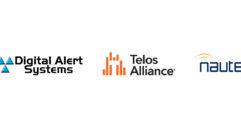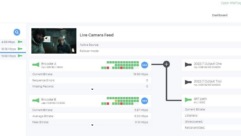
Recommended Practice Offers Impactful New Approach to Broadcasting Alerts Using Graphical Elements, an Industry First
Feb. 22, 2021 — The NextGen Video Information Systems Alliance™ (NVISA) today introduced its first recommended practice document: Visually Integrated Display Symbology (VIDS). The VIDS recommended practice represents an industry breakthrough — a powerful and impactful new way of displaying emergency alerts based on easily discernable graphical elements.
The VIDS recommended practice is intended to enhance the impact, usability, and accessibility of emergency information by incorporating graphical elements. NVISA’s objective is to contribute to a more inclusive reach of emergency information that works for all audiences, regardless of visual media, language, ability, or culture.
NVISA is a worldwide coalition of developers and manufacturers working to help accelerate the industry’s evolution toward next-generation broadcast and OTT television systems. Alliance members are pooling their cross-industry expertise to collaborate, implement standards, and create best practices to help broadcasters accelerate their transformation toward advanced ATSC 3.0 systems.
VIDS is the first-ever recommendation for integrating universally understood graphical elements, including symbols and dynamic elements, into emergency alerting information for broadcast. Until now, visual displays of public warnings have been typically text-only, and usually limited to a single language. VIDS creates a commonly defined relationship between the type of alert, the message text, and any graphical elements.
The VIDS recommended practice lays out a compelling new approach, providing a standard look and feel for advanced multimedia alerts that is fully compatible with national emergency alert requirements. The VIDS recommended practice explicitly accommodates the requirements of emergency alert systems in the United States and Canada, while providing the flexibility to be applied anywhere else in the world.
VIDS can be adopted across all manner of display technologies including broadcast media, cable and IPTV systems, and digital signage. The VIDS visual presentation is based on a set of display directives for integrating alert information in which specific icons or symbols graphically represent an emergency event. Each symbol is presented with the alert text in a highly accessible manner.
For broadcasters and cable operators, systems using the VIDS recommended practice will deliver an integrated look and feel for advanced emergency alerts, with enhanced accessibility and appeal for viewing audiences. For manufacturers and developers, the recommended practice offers a standardized method to integrate, package, and display alert text and graphics.
“Associating graphics with the audio and visual components of an alert is highly meaningful to audiences,” said Bill Robertson, chair of the NVISA VIDS Working Group 2 and vice president of business development at Digital Alert Systems. “The symbology communicates the context of the alert without requiring viewers to read the text or even understand the language. Leveraging well-known symbols and unifying them in a presentation makes it far easier for users to engage and understand the message, ultimately bringing greater impact to broadcasters’ mission of public awareness and safety.”
Integrating a range of technical and regulatory requirements, the NVISA VIDS document makes recommendations for visual presentation of emergency information on display systems, including the Emergency Alert System (EAS), Advanced Emergency Information (AEA) applications in ATSC 3.0 NextGen TV, OTT applications, digital signage, mobile applications, and other visual media. The set of graphical display elements in VIDS is derived from public policy and social science research conducted by FEMA IPAWS, the DHS Geospatial Management Office, the DHS Science and Technology Directorate, and the National Alliance for Public Safety GIS (NAPSG) Foundation.
“A significant strength of VIDS is that it provides a common, recognizable, and informative alerting and warning methodology that transcends the display device,” said Jim Altemose, president, DigIt Signage Technologies. “Whether the alert is targeted for EAS television broadcast, AEA applications, NextGen TV platforms, digital signage, or personal devices, the common symbology conveys the nature of the emergency as well as the severity in a visual way that viewers easily understand, even those with barriers such as language or color recognition.”
“NVISA created the VIDS recommended practice to benefit the entire industry, including consumers,” said Edward Czarnecki, NVISA chairman and executive director. “VIDS showcases what can be done to enhance the accessibility and visibility of emergency information in current broadcast and cable technologies, and advances what could be included in next-generation technologies like ATSC 3.0 and advanced cable applications.”
The NVISA Recommended Practice for Visually Integrated Display Symbology (VIDS), NVISA-WG-1-001.01, is freely available from NVISA for download and review at www.nvisa.org/documents. Follow the Alliance at www.nvisa.org and on Twitter @NVISA_Innovate.
# # #
About the NextGen Video Information Systems Alliance
The NextGen Video Information Systems Alliance is an international industry consortium committed to accelerating the development and practical implementation of next-gen approaches for information services over broadcast and multichannel systems. Our joint mission is to serve the needs of the industry by presenting a common voice on advanced video information issues, promoting knowledge of industry solutions for advanced broadcast and multichannel services, and driving the adoption of next-generation capabilities across the industry.
All trademarks appearing herein are the property of their respective owners.
Link to Word Doc: www.wallstcom.com/NVISA/210222-NVISA-VIDS-Emergency_Alerts.docx
Photo Link: www.wallstcom.com/NVISA/NVISA-VIDS-Emergency_Alerts-Avalanche_Warning.jpg
Photo Caption: “Avalanche” emergency alert example using VIDS graphical elements.
Photo Link: www.wallstcom.com/NVISA/VIDS-logo-BR.jpg
Photo Caption: VIDS Logo
Follow NextGen Video Information Systems Alliance:
Twitter: https://twitter.com/NVISA_Innovate
LinkedIn: https://www.linkedin.com/company/nvisa










